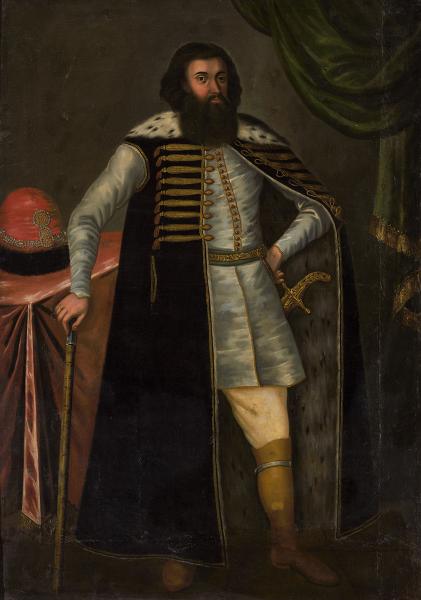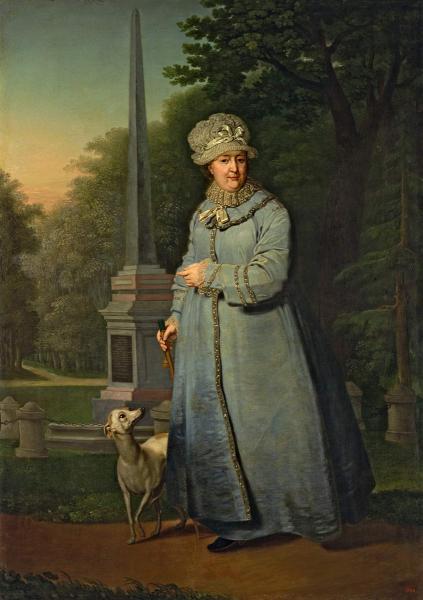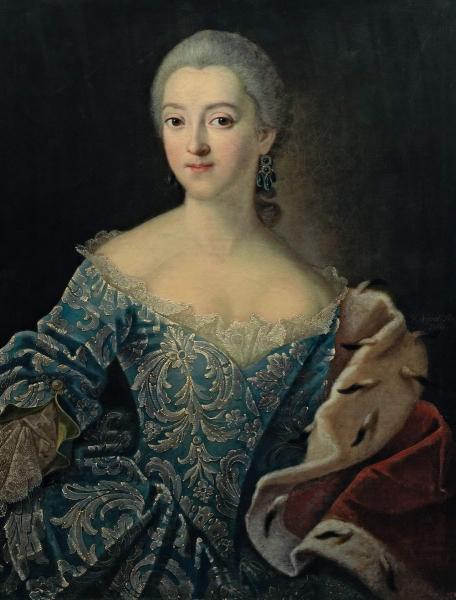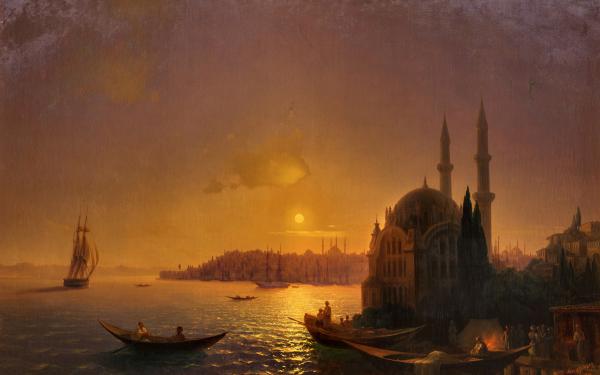The artist is unknown

Repnin Annikita Ivanovich (1668 – July 3, 1726). The middle son of the neighboring boyar and the butler of Tsar Alexei Mikhailovich Ivan Borisovich Repnin (1615–1697) and Evdokia Nikiforovna Pleshcheeva (? – April 8, 1695). Russian Field Marshal (1725). From his youth, he was under Peter I, participated in the creation of the “funny” troops. From 1685, a lieutenant, two years later he was promoted to colonels. Participated in Azov campaigns 1695–1696. In 1696 commanded a frigate. From 1699 Major General. At the beginning of the Northern War he commanded a division. By order of Peter I, he put in order Russian troops departing from Narva after a defeat in 1700. Participated in the assault on notateburg (1702) and Narva (1704). In Poltava Battle (1709) commanded the center of the Russian army. In 1709–1710 he led the siege and capture of Riga. In 1712–1713 and 1715–1716 he commanded the troops in Pomerania. Since 1719, Governor General of Livonia and at the same time in 1724–1725 President of the Military College. After the death of Peter I, he advocated the proclamation of Empress Catherine I, but was soon removed a. D. Menshikov in Riga.
Peter I. Time and environment. SPb, 2015. With. 125-126.
The traditional definition of the depicted as Prince Ivan Borisovich Repnin, adopted by almost all researchers of the second half of the XIX – early XXI century, was recently revised. The new version was adopted by the attribution council of the Russian Museum in 2014.
Peter I. Time and environment. SPb, 2015. With. 94.
There are serious reasons to consider this portrait – one of the most important and highly artistic samples of Parsun – the early image a. And. Repnin, the middle son of a neighboring boyar and the butler of Tsar Alexei Mikhailovich and. B. Repnin and n. N. Pleshcheeva. A new thorough study of repnins’s portraits undertaken in the process of preparing the exhibition "Unknown artist", confirms such a definition. Annikite Repnin in the early 1690s was about 25 years old, which corresponds to the age of the depicted. The facts of his biography allow us to clarify the time of writing a portrait: it could not be created earlier than 1695 when a. And. Repnin went with Peter on the first Azov campaign (Ovchinnikova. With. 121). The dating of the portrait by the end of the 17th century, in addition to stylistic features, is also confirmed by the study of the canvas: the seams connecting six separate pieces of the canvas into one, “exactly repeat the technique of compounding the panels of the sailing canvas that existed in Russia in the late XVII – early XVIII century”, and “ The production of a sailing canvas in Moscow arises about 1693 ”(ibid.).
Prince Ivan Borisovich, born in 1615, could not look so young in the late 1690s, when he was about 80 years old. P. N. Petrov suggested that the portraits of the repnins were “copies from ancient originals” (kat. Historical exhibition. With. 3. No. 2; With. 4. Number 3; With. 16). However, this version is unlikely, for in the first half of the XVII century, when the royal portraits were rarities, a whole group of portraits of the noble, but immeasurably lower than the status of princes of repnies could appear, could hardly appear. The likelihood that the portrait should be considered by the image of Annikita Ivanovich confirms the detail that has not yet attracted the attention of researchers, is the saber: in 1685, with the establishment of a “funeral” company in Preobrazhensky, Annikita Repnin was appointed by her lieutenant, in 1687 – was made in in 1687 – produced in Colonels. By status, he was obliged to wear weapons (sabers called Chechugi were allowed to wear only a soldier).
In the cat. 1980 (p. 366. No. 6529): Parsun of Prince Ivan Borisovich Repnin (161 (161?) –1697). The second half of the XVII in. (?).
Show the full text
Hide the full text
Portraits of the Princes of the Repnins who received the Russian Museum from IAX are extremely important and characteristic works of Parsuns, classical examples of this type of image.
According to n. M. Moleva, they come from the family meeting of the repnins, their last owner was the prince p. And. Repnin (about 1718–1778). About 1755 Prince Petr Ivanovich sold his large house with an extensive land plot of Moscow University, and portraits of repnins, together with the house, passed into possession and. And. Shuvalova, who handed them to the IAX (Molieva 1994. With. 51–52). However, for the first time “belonging to the Imperial Academy of Arts” they were mentioned in the catalog of the arranged. N. Petrov Historical Exhibition of 1870 (Kat. historical exhibition. With. 3. No. 2; With. 4. Number 3; With. 16. No. 45).
All three portraits were exhibited at the Tauride exhibition, but the catalog was mentioned as images of Prince Ivan Borisovich, Prince Athanasius Borisovich and Prince Peter Alexandrovich (Kat. Tauride exhibition . With. one. No. 1408, 1409, 1410). In the Russian Museum, upon receipt, portraits were recorded in an inventory book under the names of Ivan Borisovich, Alexander Borisovich and Afanasy Borisovich Repnins. So they were mentioned in the catalogs of the meeting and exhibitions.
Their characters allegedly belonged to the XXIII knee of the genealogical tree of the princes of repnies. Their traditional dating of the 1690s did not cause any objections, especially since they all filed in the scheme of the “Sarmatian” portrait, widespread in the Russian art of the line of the XVII-XVIII centuries.
For the first time with. AND. Letin rightly doubted that the inscription on one of the images of “Partret of Prince Alexander Borisievich Repnin” corresponds to the name of the depicted (Letin. With. 61, 62). “Russian genealogy book” p. AT. Dolgorukova clearly testifies that Prince Alexander Borisovich was absent in the “Knee XXIII”. He was formed by two sons of Prince Boris Alexandrovich – Prince Ivan Borisovich, boyar, who died on June 5, 1697, and Prince Afanasy Borisovich, who died on November 25, 1653.
The presence of three repnins brothers “Russian genealogy book” indicates only in the “Knee XXIV”. These were the sons of Prince Ivan Borisovich: Prince Andrei Bolshoi Ivanovich, Prince Annikit Ivanovich and Prince Andrei Menshoy Ivanovich (Russian genealogy book. With. 271). They are, in our opinion, models of portraits. At the end of the XVII century, the brothers were about thirty years old, which corresponds to the age of the repnins depicted on the Parsunes. N. X. Unknown artist. SPb, 2012. With. eighteen.


